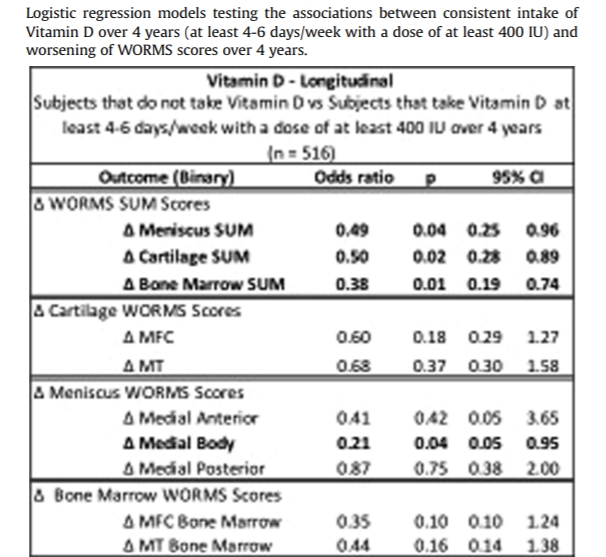Associations between Vitamin C and D intake and MR-based cartilage composition and knee joint morphology over 4 years: data from the osteoarthritis initiative
G.B. Joseph Osteoarthritis and Cartilage VOLUME 27, SUPPLEMENT 1, S352, APRIL 01, 2019
Purpose: The purpose of this study was to determine the cross-sectional and longitudinal associations of Vitamin C and D intake with MR imaging measures of cartilage composition (T2) and joint structure (cartilage, meniscus, and bone marrow), using data from the Osteoarthritis Initiative (OAI).
Methods: 1785 subjects were selected with radiographic Kellgren Lawrence knee grades 0-3 from the OAI database and with available MRI data in UCSF Radiology database. For a cross-sectional analysis, three measurements of Vitamin C and Vitamin D intake from the baseline Block Brief 2000 questionnaire were assessed: (a) daily intake from food of Vitamin C (mg) and Vitamin D (IU), (b): mean daily intake from supplements of Vitamin C (mg) or Vitamin D (IU) estimated over the past 12 months, and (c) total Vitamin C or Vitamin D intake from food and from supplements (sum of a + b). For a longitudinal analysis of Vitamin C supplement intake, 612 subjects with available data were categorized into those that had consistent intake of Vitamin C (at least 750 mg) at least 4-6 days per week at years 1, 2, 3, and 4, and those that did not take Vitamin C over the same time period. For the longitudinal analysis of Vitamin D, 516 subjects with available data were categorized into those that had consistent intake of Vitamin D (at least 400 IU) at least 4-6 days per week at years 1, 2, 3, and 4, and those that did not take Vitamin D over the same time period. Subjects with varying vitamin intake over 4 years were not included in the longitudinal analysis. The MR imaging analysis protocol included region-specific baseline 3T MRI cartilage, meniscus and bone marrow semi-quantitative WORMS gradings and cartilage T2 quantification. For the cross-sectional analysis, linear regression models were used to assess the associations between baseline Vitamin C and D intake and baseline cartilage T2 and WORMS scores. Standardized vitamin predictors and T2 outcomes were quantified by subtracting the mean of all predictors from the value for each subject and dividing by the standard deviation. For the longitudinal analysis, logistic regression models were used to quantify the associations between consistent Vitamin C or D intake over 4 years and worsening of joint morphology over 4 years. Worsening of joint morphology was designated as binary variable, and positive if the WORMS score at year 4 was greater than the WORMS score at baseline. All models were adjusted for baseline age, gender, BMI, race, education, and total calorie intake.
Results: The 1785 participants in this study had a mean age of 59.8±9.0 years and a mean BMI of 28.6±4.4 kg/m2 at baseline. Overall, higher Vitamin C intake was associated with lower cartilage T2 and WORMS scores, particularly in the medial cartilage regions. Daily total Vitamin C intake (food +supplements) had significant negative associations with cartilage T2 in the average of all regions (coeffstandardized=-0.05, p=0.04, 95% CI=-0.09 to -0.002) and in the medial tibia (coeffstandardized=-0.05, p=0.03, 95% CI=-0.09 to -0.01). Also, daily supplement Vitamin C intake had a significant negative association with baseline medial tibia cartilage WORMS score (coeffstandardized= -0.07, p=0.04, 95% CI = -0.14 to -0.001).
Daily dietary Vitamin D intake had a significant negative association with baseline cartilage WORMS sum score (coeffstandardized=-0.24, p=0.03, 95% CI=-0.46 to -0.02), and daily Vitamin D supplement intake had a significant negative association with cartilage WORMS score in the medial femur (coeffstandardized=-0.09, p=0.04, 95% CI=-0.18 to -0.003). For the longitudinal analysis, subjects with a consistent Vitamin C supplement intake over 4 years (n=39) did not have significantly different odds of WORMS progression over 4 years (p>0.05) compared to subjects that did not consistently take Vitamin C supplements (n=573). However, subjects with consistent Vitamin D supplement intake over 4 years (n=75) had significantly lower odds of WORMS progression in the cartilage, meniscus, and bone marrow over 4 years compared to those that did not (n=441), Table 1.
Conclusions: The cross-sectional results for both Vitamin C and D show that a higher intake is associated with less cartilage degeneration. While Vitamin C supplementation over 4 years did not have a significant association on changes in joint morphology, supplementation with Vitamin D (at least 4-6 days per week and 400 IU) over four years had significantly less progression of knee joint abnormalities in the meniscus, cartilage, and bone marrow. Given the retrospective nature of this study, future randomized control studies with advanced MRI outcomes would be useful for further analysis.














